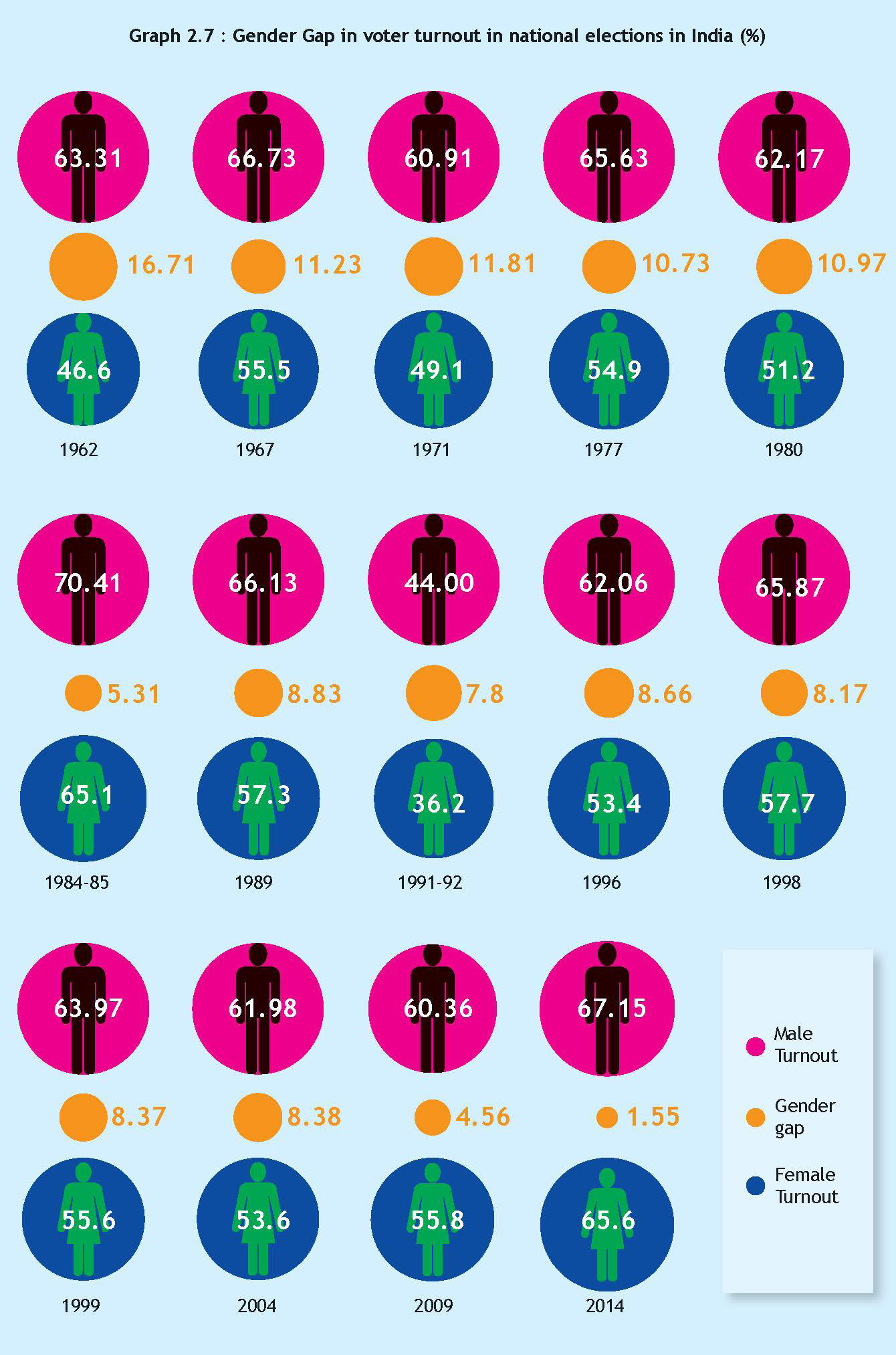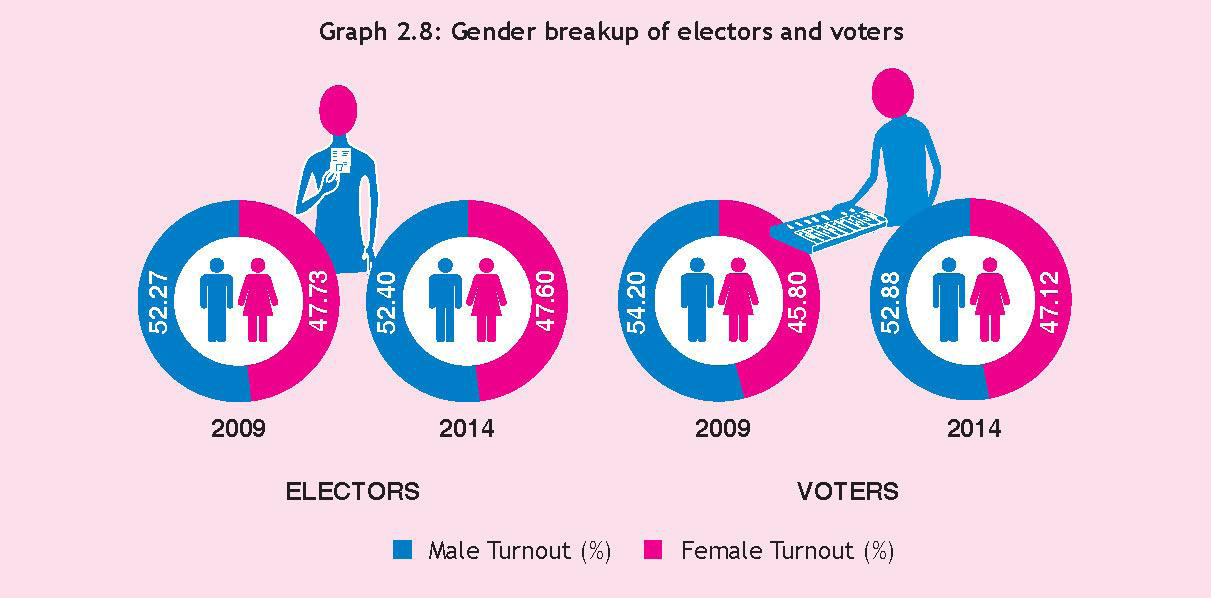
Global Knowledge Network On Voter Education - learning from each other


The voter education and outreach programme of ECI termed SVEEP (Systematic Voters’ Education & Electoral Participation) launched post 2009 national elections thus included removal of gender gap in electoral participation as one of its primary focus besides addressing issues of youth disconnect and urban apathy.
Election Commission of India(ECI) successfully converted this aspiration into a reality. This was undoubtedly a gigantic task, right from enumerating voters to locating polling booths at easily accessible places and ensuring secrecy and security of the ballot paper. The sheer number of voters and the logistical challenges on account of distances and accessibility were truly huge.
Under SVEEP, every Indian is a seen as a voter, if too young to be a current voter then a prospective one. Every Indian is also seen as a partner in the exercise of voter education. A targeted approach is adopted towards meeting the various gaps in registration and voting besides spreading awareness about informed, un-intimidated and inducement free voting under the broader framework of civic education.
Planning Interventions
Gaps are identified at the level of assembly constituencies and also at polling station level and election officials of these constituencies are given the task to identify and analyse the reason for poor women turnout. Knowledge, Attitude and Practices survey are also carried out ahead of elections to get an independent assessment about the reasons of gaps, wherever they exist.
Targeted interventions are designed based on the findings and SVEEP plans are thus chalked out for the provinces (districts). The State SVEEP Plan incorporates the plans of the districts and chalks out a comprehensive road map for the interventions in the state.
Information, Motivation & Facilitation
The SVEEP interventions have three main components for increasing the voter participation and for encouraging quality participation. Disseminating information about the ‘how’, ‘where’ and ‘when’ of registration and voting, motivating the people on ‘why’ of elections and facilitating the people so as to make the registration and voting process accessible, convenient and pleasant experience are the main components of the SVEEP interventions.
National Elections for Lok Sabha 2014
For maximization of women registration, women-specific campaign was a substantive part of the SVEEP Plan at state and district level. Cultural interventions were planned out to address the issue of lack of voters’ education among women. As a component of BLOs’ training, sensitization to issues regarding women’s registration as electors was done.
 Vignettes-
Vignettes-
Marching On: All Women’s Rallies in Sabarkantha, Gujarat
All women rallies, locally called ‘Mahila Matdaar Rallies’ were organised in district Sabarkantha of Gujarat which is predominantly a tribal district. The low female voter turn-out polling stations were already identified in the district, but it was a revelation for the election administration when they found out that women in these PS areas were not even aware that they had a right to vote.
Every week, Wednesday is the day fixed to immunize young children by health workers all over the State. This is known as Mamta Divas. The District Election Officer (DEO) decided to hold these rallies on Wednesdays in the low female turnout areas. The rally would consist of the Health Workers, Anganwadi workers, Self Help Group members, and since it was strategically decided to start the rally from the Health Centre (Mamta Kendra), the female beneficiaries present for immunization would join in the rally. These women would then go into the streets of the Polling Station area shouting innovative slogans and carrying informative banners about the right of women to vote, the time and date of polls, separate queues for woman etc. In the district, 80,000 women participated in 826 such rallies, ahead of LS 2014.
Vignettes-
Mothers take the lead in Reasi, Jammu & Kashmir
In District Reasi of Jammu & Kashmir, "Mother India" campaign was launched through 942 volunteers targeting women voters and prospective female voters ahead of LS 2014. Under the campaign electoral literacy material was distributed, voter lists were circulated at household level in villages and electoral participation pledge in Urdu, Gojri and Kashmiri languages was got signed from women voters. All 301 Polling Stations in the district were declared as “No Women Queue” with seating arrangements with 200+ chairs made at these polling booths. Women were given a warm welcome, offered token and place to sit. After every male voter two female voters were allowed to enter the polling booth to facilitate greater number of women and their timely return to homes. At the Polling Stations a special “Women Help Desk” was established to help the female voters and facilitate their voting. Drinking water facility, facilitation counter, were made available and these facilities were widely publicized before poll date to encourage women to come and vote.
Vignettes-
Mother Daughter Conversation
Communication material are developed which specifically targeted women. Following is an example from Uttar Pradesh, the most populated state of India:
Dear mother, don’t stop me, I will go to vote
Listen daughter, I will not send you outside
Stay at home and work, I will not send you outside
Dear mother, your aunts would go to vote
Your old grandmother will go to vote
Listen daughter, I will not send you outside
Stay at home and work, I will not send you outside
Dear mother,
Listen to me, pay attention; I have got my voter slip
My name is in the rolls and I am a voter
Dear daughter, how can you be a voter without being married?
Dear mother, I am eighteen years old, my name is in the voter list, the Tehsildar came to school and showed us the voter list
I will take everyone with me to vote
I will perform my duty
Dear daughter, thanks for enlightening me, I will vote and make sure you vote too
Vignettes-
Shouldering New Responsibilities: Targeting young married women – Bharuch, Gujarat
Young married women were assisted in Bharuch for obtaining supporting documents for voters’ registration with the help of ASHA and Anganwadi workers, in an organized campaign to enrol young women who are generally not enrolled after marriage. Gujarat state has a history of high gender gap, both at the level of enrolment and in voting. Special motivational and information campaign was taken up particularly targeting women through folk art and competitions. As a result of these sustained efforts, the female voter turnout in Bharuch was 73.91%, an increase of 11% in 2012 Assembly Election over last Assembly election. The DEO Bharuch won the Best Electoral Practices Award for the year 2012.
Engagement of women icons for promotional messages at national level was done. Women groups such as Self Help Groups and Women cooperatives were also engaged with for voter education. Street plays, folk songs, drama, Cinema slides, posters at places frequented by women such as religious places, ration shops, markets and hospitals were used.
Specific activities to attract female voters to register, including activities informing them how married women can register, were taken up as a part of the Plan. Grassroots level workers under the Mid-Day Meal Scheme, ASHA and Aanganwadi workers of the Integrated Child Development Scheme (ICDS) were trained to facilitate registration of young female voters.
Women election icons, Women BLOs and all women polling staff were some of the other strategies to bring in more women in the electoral process.
Outcome
As per the electoral data1 of the final publication of Summary Revision 2014, male electors constituted 52.4%, female electors 47.6% and electors belonging to the “Others” category constituted 0.0035% of the total electorate. Among the 28 States and 7 union territories, in 8 States/UTs2 the number of female electors exceeded that of male electors.
Nearly 65.63% of the total women electors in the country voted in 2014 election, as compared to 55.82% in 2009 poll. In comparison, 67.09% of the male electorate turned up at the polling stations, as compared to 60.24% in the last general election. The gap between male and female turnout was narrowest in the 2014 election.
Thus women had a greater share in the credit for highest ever turnout ever recorded in Lok Sabha election 2014, as the surge in female voter turnout has been higher than the corresponding rise in male turnout. While in 2009 gender composition of voters was adverse to the gender composition in total electorate, in 2014 the gender composition in voter and electors was similar.
As many as 16 States/UTs3 recorded higher women turnout in 2014, as against six States/ UTs in 2009 polls. Of these, 9 States/UTs4 - saw higher women turnout percentage than men for the first time in Lok Sabha election history. Also LS 2014 saw higher women voter increase than women electorate increase over 2009. While women electors increased from 342.2 million in 2009 to 397 million, women voters increased from 191 to 260 million in 2014. The trend was seen across the States/UTs with most recording higher increase in women voters against increase in women electors.
In subsequent provincial elections from 2015-2017, the increase in women’s turnout continued and the gender gap in electoral participation has further narrowed down.
Recent Initiatives
All Women managed Polling Stations
Started as an innovative idea in West Bengal in the 2014 Lok Sabha election, women managed polling booths have now become a major highlight in elections. These polling stations have generated a lot of curiosity and buzz among people as well as media. The polling stations specifically set up in identified constituencies are managed by team of all women officials, right from security personnel to polling officials to micro-observers. This, besides symbolically sending out a message, also encourages women voters to turn up and vote.
Vignettes
Red zone turned Pink for election: Women managed Polling Booth in Gaya, Bihar
During the provincial election in Bihar in 2015, all women managed booth ‘Mahila Booth’, also termed ‘Pink Booth’ were set up with all women polling personnel donning pink attires! This was followed up by an all women model counting centre where the counting was also totally managed by women personnel and security provided by women police. The polling agents too were women as the contesting candidates appointed female polling agents, another first ever in history of Bihar. Indeed, the terror affected red Gaya district turned pink with festivities of elections!
Women Mascots
Use of mascots in elections for spreading the message of electoral participation has been seen as an effective communication strategy in recent elections. The mascots are region specific, and communicate with the populace in local language, delivering the important message in an easy and relatable manner. Many province in recent elections experimented with female mascots e.g. Titabar in Assam had their mascot ‘Bhoni’ meaning younger sister while West Bengal used the state mascot ‘Ananya’.
Reaching out to Third Gender
Following the landmark decision of the Supreme Court of India, recognizing transgender as the ‘Third Gender’, outreach campaigns have been taken up to educate and facilitate transgenders to register themselves as ‘Third Gender’ if they choose to do so, and encourage them to exercise their democratic right of voting.
One of the prominent transgender activist has been roped in as the Icon or ambassador to motivate the community for their electoral participation. Educational and motivational content has been created specifically targeting the transgenders.
This outreach campaign was taken up rigorously in Maharashtra, in districts with significant population of the third gender. Osmanabad district in Maharashtra recorded 93.75% transgender turnout in LS 2014. Third genders in Kalyan, Thane, Mumbai, Pune Solapur, Palghar and Nashik came out in large numbers to vote.
The Road Ahead
To assess the efficacy of implementations and derive learnings for improvement, mid period review and constant monitoring of SVEEP programmes are conducted. Regular Video Conferences are organised by CEO with all DEOs for review of implementation. The programme is reviewed at the national level by the Director General who keeps the Commission briefed. Statistical studies, innovations and case studies along with the creative material produced are compiled at DEO and CEO level and shared with the Commission for replication and scaling up.

The gender gap has been distinctly reducing over the years and that is a significant achievement. But continued efforts are still required to completely eliminate this gap and bring complete gender parity in participation.
SVEEP has harvested the relatively easier crop and the next earning in terms of participation is not coming easy. This is the latest experience from states which registered high increase in women’s turnout immediately after SVEEP was launched in 2009-2010, but where SVEEP is struggling to increase the women turnout percentage further and from States where SVEEP programme is being called to work harder for retaining the spurt in participation that they achieved in last election.
Engaging with future voters through electoral literacy in curricula and extra-curricula has now emerged as one of the focus areas and Election Commission of India now aspires for complete and enlightened participation in coming years.
The principle, philosophy, spirit and vision of SVEEP lie in empowerment of the citizen to voluntarily register and ethically vote in each and every election and also to inculcate a perpetual and responsible democratic awareness. This participation leads to larger and wider engagement within and with the system of democracy, governance and development with a win-win situation for the citizen and the nation.
Padma Angmo
Director,
Election Commission of India.